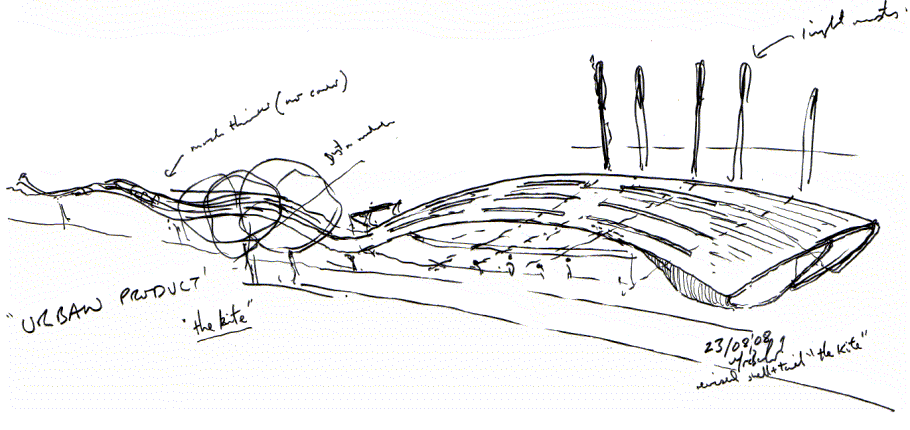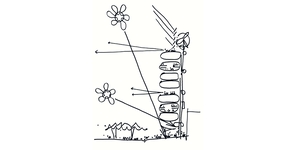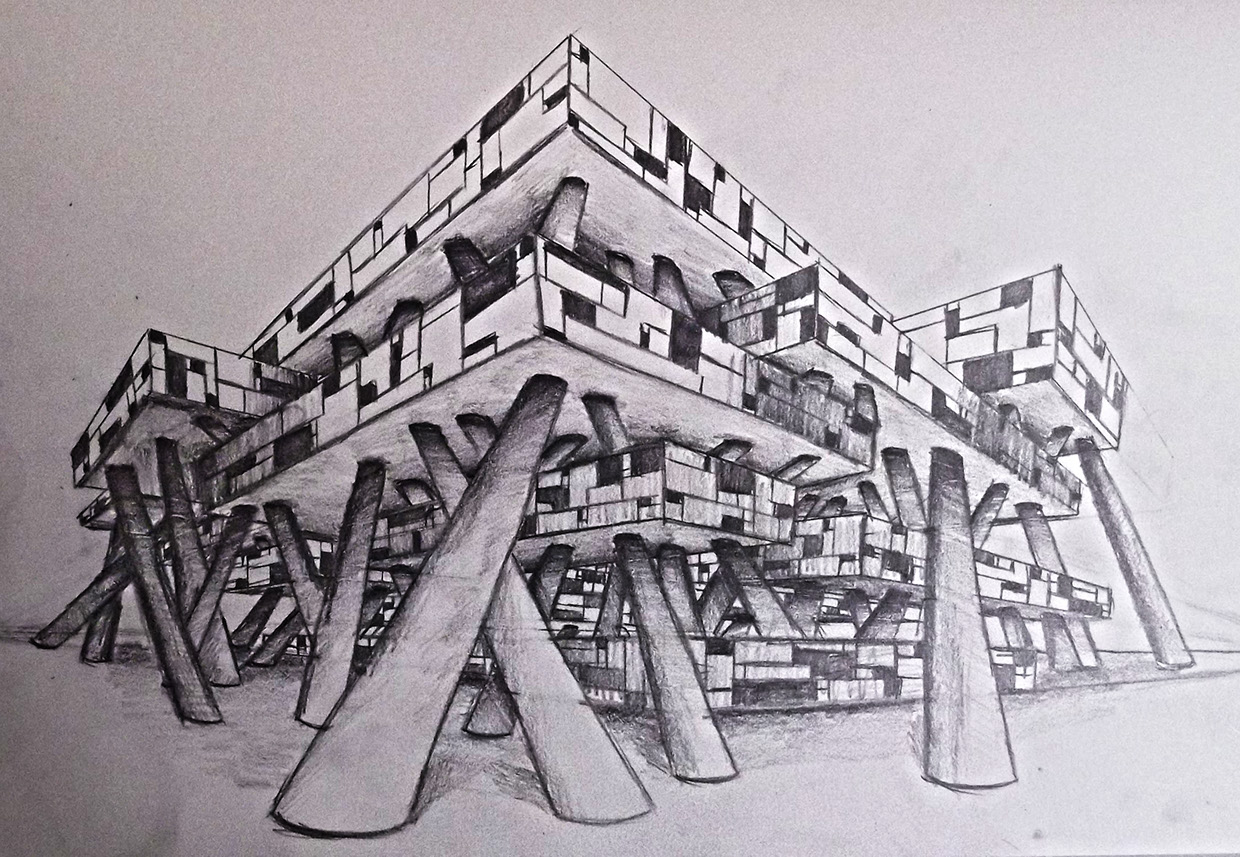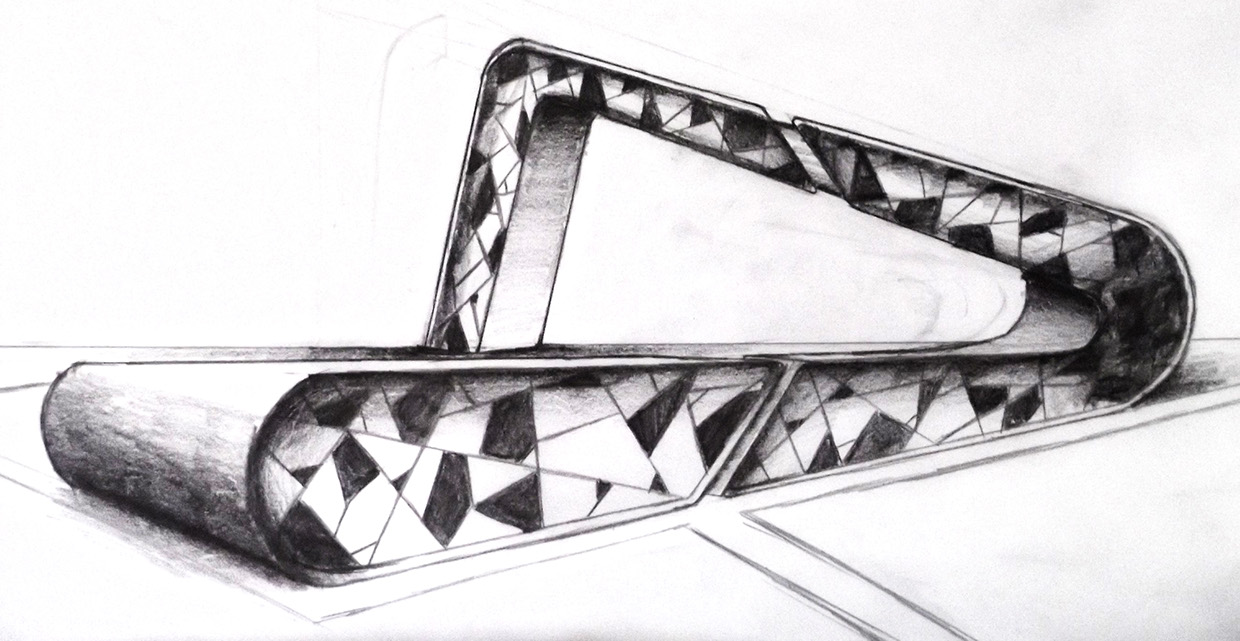Concept drawing
Concept drawings or sketches are drawings, often freehand, that are used by designers such as architects, engineers and interior designers as a quick and simple way of exploring initial ideas for designs. They are not intended to be accurate or definitive, merely a way of investigating and communicating design principles and aesthetic concepts.
Concept drawings can also be used to explore more technical aspects of a design, providing an initial response and possible solutions to problems, constraints and opportunities such as services layout, structure, method of construction, solar paths and shading, prevailing wind, patterns of circulation, relationships between aspects of the site and so on.
Much is made of the architect’s ‘back of a cigarette packet/napkin’ sketch that then becomes the basis for a building design. Indeed, this is reportedly how Renzo Piano came up with the design for The Shard, and Mike Davies from RSHP developed the initial idea for the Millennium Dome.
See also: Techniques for drawing buildings.
Preliminary sketches capture and communicate the essence of an idea, focusing on its driving features, and in the same way that an artist sketch is often more evocative than a finished painting, concept drawings can sometimes capture the sense of an idea more clearly than later drawings or even the completed building.
Concept drawings, using pencils or felt tip pens and paper can provide a more fluid, expressive and faster method for investigating a problem, than more hi-tech approaches such as computer aided design or building information modelling which can be restrictive in terms of the precision they require and the rules they impose on the way an image is constructed.
Writing exclusively for Designing Buildings Wiki, RSHP’s Mike Davies explains:
“Concept design requires that the architect grapples with the real issues of form and bulk, scale and mass and the generic appearance of a building within its surrounding urban context, resolving and encapsulating the principles of the scheme. Concept design implies an idea, or range of ideas, a development approach, a guiding concept and a design intent. It resolves the issue of ‘what’ and ‘how much’ and begins to set the stage for understanding ‘how’.
“Concept design can be simply a series of sketches, ideas and explorations, or it can go into considerable depth, including design illustrations, indicative plans, sections and elevations and 3D models of a development approach.”
The challenge of the subsequent design process is often one of protecting the original concept to ensure it is not diluted or even lost altogether under the pressures of technical, legislative, budgetary and time constraints.
Below are two example concept sketches from architect Corlandus Lang.
[edit] Related articles on Designing Buildings Wiki
- As-built drawings and record drawings.
- Assembly drawing.
- Building information modelling.
- Component drawing.
- Computer aided design.
- Concept architectural design.
- Design drawings.
- Design information.
- Detail drawing.
- Elevations.
- Engineering drawing.
- General arrangement drawing.
- Installation drawings.
- North American Paper Sizes
- Notation and symbols.
- Paper sizes (ISO 216 A, B and C series)
- Production information.
- Scale drawing.
- Section drawing.
- Shop drawings.
- Site plan.
- Spatial diagram.
- Specification.
- Technical drawing.
- Techniques for drawing buildings.
- Types of drawings for building design.
- Working drawing.
Featured articles and news
Government consultations for the summer of 2025
A year of Labour, past and present consultations on the environment, the built environment, training and tax.
CMA competitiveness probe of major housing developers
100 million affordable housing contributions committed with further consultation published.
Homes England supports Greencore Homes
42 new build affordable sustainable homes in Oxfordshire.
Zero carbon social housing: unlocking brownfield potential
Seven ZEDpod strategies for brownfield housing success.
CIOB report; a blueprint for SDGs and the built environment
Pairing the Sustainable Development Goals with projects.
Types, tests, standards and fires relating to external cladding
Brief descriptions with an extensive list of fires for review.
Latest Build UK Building Safety Regime explainer published
Key elements in one short, now updated document.
UKGBC launch the UK Climate Resilience Roadmap
First guidance of its kind on direct climate impacts for the built environment and how it can adapt.
CLC Health, Safety and Wellbeing Strategy 2025
Launched by the Minister for Industry to look at fatalities on site, improving mental health and other issues.
One of the most impressive Victorian architects. Book review.
Common Assessment Standard now with building safety
New CAS update now includes mandatory building safety questions.
RTPI leader to become new CIOB Chief Executive Officer
Dr Victoria Hills MRTPI, FICE to take over after Caroline Gumble’s departure.
Social and affordable housing, a long term plan for delivery
The “Delivering a Decade of Renewal for Social and Affordable Housing” strategy sets out future path.
A change to adoptive architecture
Effects of global weather warming on architectural detailing, material choice and human interaction.
The proposed publicly owned and backed subsidiary of Homes England, to facilitate new homes.
How big is the problem and what can we do to mitigate the effects?
Overheating guidance and tools for building designers
A number of cool guides to help with the heat.
The UK's Modern Industrial Strategy: A 10 year plan
Previous consultation criticism, current key elements and general support with some persisting reservations.
Building Safety Regulator reforms
New roles, new staff and a new fast track service pave the way for a single construction regulator.





























